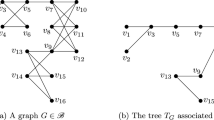Abstract
We introduce [k,d]-sparse geometries of cardinality n, which are natural generalizations of partial Steiner systems PS(t,k;n), with d=2(k−t+1). We will verify whether Steiner systems are characterised in the following way. (*) Let \(\Gamma=(\mathcal{P},\mathcal{B})\) be a [k,2(k−t+1)]-sparse geometry of cardinality n, with \(\frac{n+1}{2} \> k \> t \> 1\). If \(|\mathcal{B}| \ge {n \choose t}/{k \choose t}\), then Γ is a S(t,k;n). If (*) holds for fixed parameters t, k and n, then we say S(t,k;n) satisfies, or has, characterisation (*). We could not prove (*) in general, but we prove the Theorems 1, 2, 3 and 4, which state conditions under which (*) is satisfied. Moreover, we verify characterisation (*) for every Steiner system appearing in list of the sporadic Steiner systems of small cardinality, and the list of infinite series of Steiner systems, both mentioned in the latest edition of the book ‘Design Theory’ by T. Beth, D. Jungnickel and H. Lenz. As an interesting application, one can use these results to build (almost) maximal binary codes in the following way. Every [k,d]-sparse geometry is associated with a [k,d]-sparse binary code of the same size (let \(\mathcal{P} = \{ p_1, \ldots, p_n \}\) and link every block \(B \in \mathcal{B}\) with the code word \((c_i)_{1 \le i \le n}\) where c i =1 if and only if the point p i is a member of B), so one can construct maximal [k,d]-sparse binary codes using (partial) Steiner systems. These [k,d]-sparse codes can then be used as building bricks for binary codes having a bigger variety of weights (the weight of a code word is the sum of its entries).
Similar content being viewed by others
References
T. Beth D. Jungnickel H. Lenz. (1999) Design theory. Vol. I., volume 78 of Encyclopedia Math. Appl. Cambridge University Press Cambridge.
T. Beth D. Jungnickel H. Lenz (1999) Design theory. Vol. II., volume 69 of Encyclopedia Math. Appl. Cambridge University Press Cambridge.
Hering C. (2000).On codes, sparse codes and Steiner systems. Math. Inst. Tubingen University,
Author information
Authors and Affiliations
Corresponding author
Rights and permissions
About this article
Cite this article
Kaey, J.D. On a More General Characterisation of Steiner Systems. Des Codes Crypt 36, 117–129 (2005). https://doi.org/10.1007/s10623-004-1699-z
Received:
Revised:
Accepted:
Issue Date:
DOI: https://doi.org/10.1007/s10623-004-1699-z




